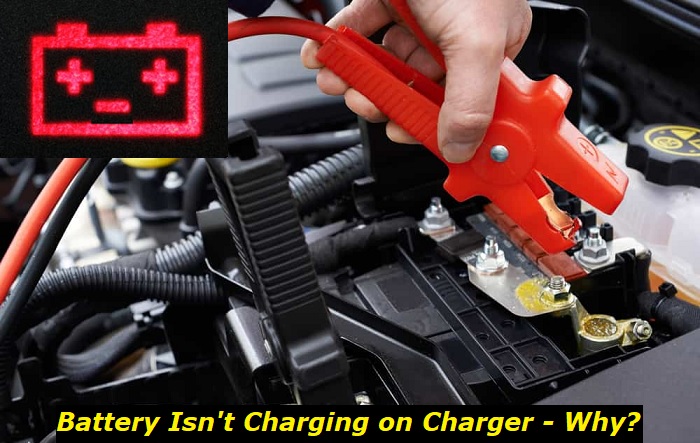A car battery that doesn't charge could get you into a series of emotions you do not want to deal with when you are busy and in a rush. But when the battery light showed up after starting your car and did not disappear, you can confirm it is not charging.
Whether you like it or not, you must deal with it or face the road sooner with failing electrical components because of lack of power.
Car battery charging highlights
- Critical voltage:lower than 12 volts
- Target voltage:12.5 volts
- Charging voltage:14 - 14.7 volts
- Charging time:defined by tender
- Risks:battery death
- DIY solution:yes
- Tools needed:charger, power socket
- Price:$1

Reasons your Car Battery is Not Charging
1) Dead Battery
When your car battery has depleted all the chemical energy inside, it will not hold a charge anymore. No matter how the alternator tries to generate power or how the charger refills energy, it will not work.
Apart from the battery warning light, you will notice different signs of it not working:
- The engine will crank slowly. If it's not hard-cranking, you may hear the engine clicking when you try to turn the engine over.
- The lights or other electronic devices will not work. Head and tail lights will display dim lighting. Your dashboard, radio, and other electronic devices will not light up when turning on the ignition.
- The battery is either swollen or leaking. A discharged battery may freeze or expand, which stretches the casing.
In any of these cases, your only fix is to replace the car battery.
2) Poor Battery Condition
Poor battery condition is a result of many factors. When the car battery is on the verge of dying, it would be wiser to replace it.
A car battery's condition becomes poor as it ages. This condition is unavoidable even if you have maintained the unit accordingly.
Also, if the battery has stuck up for too long, it may lose the ability to charge. Overcharging can damage its cells and lead to poor battery conditions.
And lastly, exposure to extreme temperatures can also affect its charging ability.
To know if your battery is in poor condition, test it and inspect its connections. Sometimes it only has poor connections.
But if the connections are in good condition and the battery is not charging, replace the weak battery.
3) Poor Battery Connections
Poor battery connections are the result of corroded or dirty contacts between the battery and cables. It not only causes poor connection but the intermittent flow of electricity.
Here's what you can do to check and fix their connections.
- Turn the engine off.
- Perform visual inspection on battery connections. Look for signs of corrosion or loose wire connections.
- Remove the battery cables.
- Clean them using a wire brush. There are specific battery cleaners in the market you can use.
- Reconnect the cables.
4) Faulty Battery Charger
A faulty charger will have trouble working or delivering power to the battery. There are many causes why a charger fails to do its work. One reason is loose or broken cables. This event interrupts the supply of battery voltage. If this is the case, try reconnecting broken cables.
Overcharging and undercharging are one of the common causes why a battery charger would not work. It may overcharge or undercharge when the charger is not set to the required voltage. You need to set the charger to the correct amperage or voltage when setting the charger.
Another problem is a blown fuse. A blown fuse will prevent the charger from passing on voltage to the battery. If this is the problem, you can try replacing the fuse. Also, avoid emptying your car battery before charging. So, it does not have to pull too much current, cause a surge, and burn the fuse.
5) Bad Alternator
An alternator is supposed to replenish used-up power in the battery. But when it becomes faulty, it will not generate power to charge the battery. Here are some signs that there is a problem with your alternator:
- The headlights are dimming.
- The battery warning light is on.
- Other electrical components seem to be unresponsive or responding late.
You can confirm this by testing your alternator. Use a multimeter to check the reading. It should read at least 12.3 volts and more. Also, inspect the belt and see any signs of damage or breaking.
You can also perform a stress check on your alternator. Turn on your engine and all other electrical components. See if the voltage output remains over 12.3 volts. Next, rev up your engine and see if the output increases.
You can also test the diode of the alternator. Set the multimeter to diode mode. It should read 0.6 to 0.7 volts in an open circuit or one direction. Having readings in both directions means your alternator is faulty.
If you find it needs replacements, call your mechanic.
6) Faulty Voltage Regulator
The voltage regulator controls the voltage output of the alternator. When this part becomes faulty, your battery will not charge according to the recommended rate. A faulty voltage regulator causes the battery to overcharge or undercharge.
When the voltage regulator is malfunctioning, lights often dim and flicker. Aside from undercharging and overcharging, you may smell something burning or smoking from the alternator.
Here's what you can do, check for damaged or loose wiring connected to the regulator. If the wiring is in good shape and you still see symptoms, replace your voltage regulator and install it properly.
7) Blown Fuse
Fuses are most often taking the surge of electricity to protect other electrical devices and wirings. When it blows, it will interrupt the electric flow ad disrupt the electric circuit between the alternator and battery.
Here's how to find out if your alternator has blown fuse.
- The electrical devices are not working.
- You can smell something burning on the fuse box.
- The battery does not charge.
- The fuse has burned.
In these cases, replace your fuse.
8) Aftermarket Device Continuous Power Usage
When aftermarket devices run continuously, even if the engine is off, it would drain the battery if someone tinkered with the wires. Car alarms, GPS trackers, audio systems, dashboard cameras, and phone charges are examples of aftermarket devices that may have been running even the engine is off. Constant draining depletes the battery and causes it not to charge.
These devices should shut off along with the engine. But some people would touch the wires to access it live. After all, shutting it off may remove their settings.
To fix this issue, let your service technician reconnect the wires. So, they work at default settings, where they shut off when the engine is off.
9) Broken Drive Belt
The serpentine belt drives the alternator that charges the battery. When this belt breaks or becomes loose, the alternator will not spin and charge the battery. Drive belts break for many reasons: overheating, wear and tear, improper installation, tensioner, and faulty pulleys.
The signs that your drive belt is loose or has broken are engine overheating, battery warning lights, steering difficulty, and squawking noises.
Tighten your drive belt if it is loose. And replace it if the belt has broken.
10) Parasitic Draining
Parasitic draining continues to drain your battery even if you have turned the engine off. It would not only cause the battery not to charge, but it would continuously drain your battery even not in use. Not only aftermarket devices do this.
Parasitic draining is a result of faulty electrical components like a power window motor. If you have left your dome or trunk light on, it will cause your battery. Short circuits also prevent the battery from charging correctly while continuously draining the battery.
Trace the circuit causing parasitic draining by performing a series of tests. Otherwise, this event will shorten your battery life. We advise consulting experts for this matter.
11) Defective ECU
The Engine Control Unit (ECU) controls many electrical systems in your vehicle, including your battery charging system. When the battery is low on charge, it will tell the dash to illuminate and show a warning light. When the battery is full, it also shows. However, when it detects a problem with charging, it also shows a warning light. When the battery fails, the ECU takes charge of control.
However, a lot of reasons can affect its performance. Failing internal components, water damage, short circuits, and programming issues can affect communication with the charging system.
In this case, you'll need to run diagnostic tests with an OBD II scanner. Your ECU stores errors in your vehicle. It is wiser to invest in a scanner for easy diagnosis of trouble codes. Your technician should be able to fix these problems detected in your scanner.
How to Diagnose a Car Battery Not Charging?
Here's how you can diagnose your car battery that is not holding a charge.
- Test your battery voltage. It should have at least 12.3V or more.
- Inspect your alternator ad alternator belt.
- Test the alternator output.
- Inspect the connections visually and look for signs of damage, looseness, or breaking.
- Head over to the fuse box. See if any fuse has blown.
- Inspect your voltage regulator.
- Run error codes on ECU.
Final thoughts
No one should ignore a battery not charging. It can cause damage to electronic devices. It could leave you stranded in the middle of the road when the battery loses power. Additionally, your battery lifespan will reduce. It can lead to costly repairs. Not having enough charge can lead to serious safety risks when your brake or headlights become dim or shut off. If you are uncomfortable diagnosing the problem, contact your technician for an accurate diagnosis.
About the authors
The CarAraC research team is composed of seasoned auto mechanics and automotive industry professionals, including individuals with advanced degrees and certifications in their field. Our team members boast prestigious credentials, reflecting their extensive knowledge and skills. These qualifications include: IMI: Institute of the Motor Industry, ASE-Certified Master Automobile Technicians; Coventry University, Graduate of MA in Automotive Journalism; Politecnico di Torino, Italy, MS Automotive Engineering; Ss. Cyril and Methodius University in Skopje, Mechanical University in Skopje; TOC Automotive College; DHA Suffa University, Department of Mechanical Engineering






Add comment